A visit to Dhanushkodi makes one wonder as to how such peace and tranquility can at times, also unleash such fury and destruction, but then life goes on, as does for the small section of the fisherfolk who continue to inhabit the island and depend on it for their basic needs of food and drinking water, which the island continues to provide for them, often in miraculous ways!
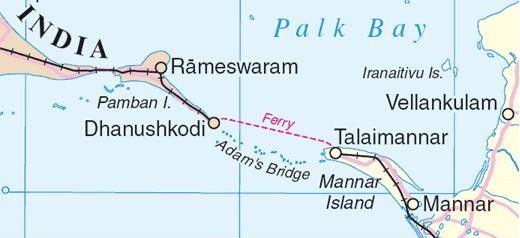
A map showing the location of Dhanushkodi island (Source: Wikimedia Commons)
Our visit to Dhanushkodi
Our visit to Dhanushkodi is totally unexpected and a memorable one. We decide to go to Dhanushkodi as a part of our visit to Rameshwaram and expecting a crowded place, are taken aback by the exceptionally bumpy ride by a jeep to this island, which enchants you with its beautiful views of the two oceans namely the Bay of Bengal and the Indian Ocean, but at the same time leaves an eerie feeling with its emptiness and a view of the ruins that give you the impression that this has been a different place before.
This deserted island is occupied by hutments of fisherfolk who seem to live in isolation and with no connection other than jeeps to the mainland and their main means of survival seems to depend on the fish they catch from the sea. With no basic facilities to depend on, we come across an interesting way in which women from these communities get their drinking water and wonder if this is the place where reality coexists/mingles with myths, mysteries and miracles turning it into a seemingly unique location.
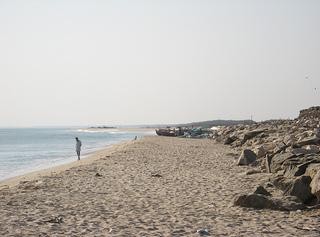
A view of the ocean at Dhanushkodi
Dhanushkodi as we see it today
Bordered by the Bay of Bengal on one and the Indian Ocean on the other, Dhanushkodi, some 20 kilometres away from Rameshwaram, is one of the most spectacular stretches of Tamil Nadu with not more than 50 fisherfolk dwellings with a population of around 500.
Myth says that this is the place where Lord Rama pointed to with the tip of his bow and Lord Hanumana along with his army built a bridge (Setu) to cross the sea to reach Sri Lanka. Indeed, Sri Lanka is just 31 kilometres away from Dhanushkodi.
A visit to Dhanushkodi takes your breath away and is a visual treat with incredibly beautiful views of the clear blue sea, but at the same time envelopes you with sadness with its ruins and the dilapidated remains of what was once a flourishing town. Dhanushkodi was a major point of entry to India until 1964, when a cyclone devastated the entire town, washing away the railway track, a steam engine and its carriages, and the entire village.
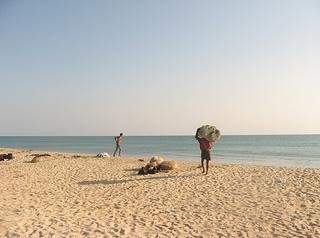
A view of the ocean at Dhanushkodi
The cyclone in 1964 that destroyed Dhanushkodi
There were many ferry services between Dhanushkodi and Talaimannar of Ceylon (now called Sri Lanka), transporting travellers and goods across the sea. There were hotels, textile shops and dharmashalas catering to these pilgrims and travellers. Dhanushkodi, in those days, also had a railway station, a small railway hospital, a higher secondary school, a post office, customs and port offices etc. One can still see the sad remains of the railway line, some of the ruins of the offices and the hospital and the old school, which is reused now for the 500 inhabitants who continue to stay on the island . Before the cyclone, there was a train service up to Dhanushkodi called Boat Mail from Madras Egmore (Now Chennai Egmore), which would halt on the south-eastern side of Dhanushkodi township, where a waiting steamer transported passengers to Sri Lanka [1].

A fisherman venturing out into the sea at Dhanushkodi
A depression with its centre in South Andaman Sea on 17 December 1964 is what brought about this cyclone. On 19 th December, it intensified into a cyclonic storm. After 21 December 1964, it started moving westwards at the rate of 250 miles (400 km) to 350 miles (560 km) per day. On 22 nd December, it crossed Vavunia of Ceylon ( now called Sri Lanka) with a wind velocity of 280 km/hour, moved into Palk Strait in the night and crashed into Dhanushkodi of Rameshwaram island on the night of 22–23 December 1964. It was estimated that tidal waves were 8 yards high when it crossed Rameshwaram [1].

The fishing boats venturing out into the sea at Dhanushkodi
On that night (December 22) at 23.55 hours while entering Dhanushkodi railway station, the train No.653, Pamban-Dhanushkodi Passenger, a daily regular service which left Pamban with 110 passengers and 5 railway staff, was only few hundred yards before Dhanushkodi Railway station when it was hit by a massive tidal wave. The entire train was washed away killing all 115 on board. A few metres ahead of Dhanushkodi, the signal failed. With pitch darkness around and no indication of the signal being restored, the driver blew a long whistle and decided to take the risk. Minutes later, a huge tidal wave submerged all the six coaches in deep water. The tragedy that left no survivors also destroyed the Pamban bridge, which connected the mainland of India to Rameshwaram island [1].
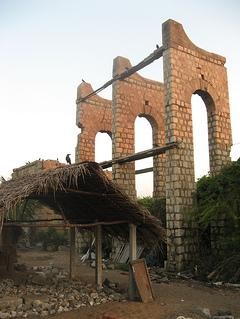 A view of the ruins from the cyclone at Dhanushkodi
A view of the ruins from the cyclone at Dhanushkodi
Reports say that over 1800 people died in the cyclonic storm. All houses and other structures in Dhanushkodi town were marooned. The high tidal waves moved deep onto this island and ruined the entire town. Naval vessels sent to rescue people reported seeing several bloated bodies around the eastern end of Dhanushkodi. Eyewitness accounts recollected how the surging waters stopped short of the main temple at Rameshwaram where many people had taken refuge from the fury of the storm. Following this disaster, the Government of Madras declared Dhanushkodi a ghost town and unfit for living [1].
Fisherfolk staying in Dhanushkodi
Only a few fisherfolk now live here. One can now reach Dhanushkodi either on foot along the sea shore by the sand dunes or in jeeps and tempos of fishermen. A ride down this 20 km long straight road leading to the ruins of the township is an exciting experience in itself. We have hired a jeep and the driver is a resident of the village itself. During the bumpy ride, he shows us the remains of the rail tracks covered with sand, and those of the school, the hospital and office buildings. He also shows us the village that includes some 50 households staying in makeshift thatched houses.
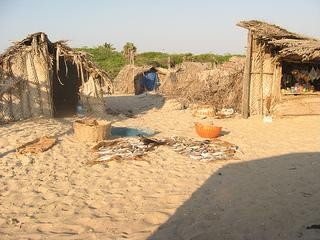
The thatched huts of the fisherfolk who live on the island
We ask him to take us closer to the clustered villages, all made up of thatched roofs with children playing alongside the houses who run up to us to sell sea shells. The dwellings here seem to survive mostly on fishing, besides getting some income from the small number of tourists who brave their way here by traveling in old jeeps and a very bumpy ride. We go around in the village and find some of the fishermen with their boats collecting their catch for the day. We also see a few women washing clothes near a well and wonder where they get their water from. There seem to be a few wells that have salty water that people use for washing clothes and utensils.
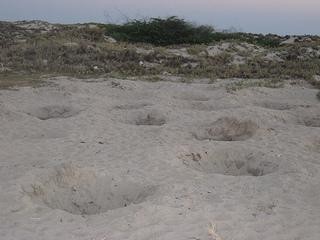
Pits made in the sand that provide sweet drinking water to the fishing community
Sweet drinking water found on the sandy beach flanked on both sides by the two oceans
We wonder about the drinking water availability in the villages and follow two women who show us a sandy place, which lies bordered between the two oceans on the two sides.The women tell us that all from the villages come here to get water. We watch and wonder while the women start digging in the sand with their bare hands to make a pit, to find water in the pits!
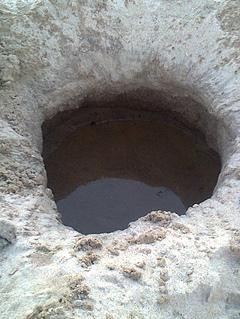
The water source that provides sweet drinking water to the fisherfolk at Dhanushkodi
The women collect this water, filtering it through a piece of cloth in their pots. They offer us some water. We are surprised to find that the water is very sweet and free of any salt!

Women from the fishing communities collecting drinking water from the pits made in the sand
We reach the end of the land where the two oceans meet and take in the view of the deep blue sea, gradually changing colours with the setting of the sun and the rising of the moon, wondering how such peace and tranquility can at times, also unleash such fury and destruction, but then, time goes on and heals all wounds!
References
1. Dhanushkodi: The Wikipedia, the Free Encyclopedia. Downloaded from the link http://en.wikipedia.org/wiki/Dhanushkodi on the 14th of March 2013
/articles/story-dhanushkodi-cyclone-hit-town-where-reality-coexists-myths-mysteries-and-miracles